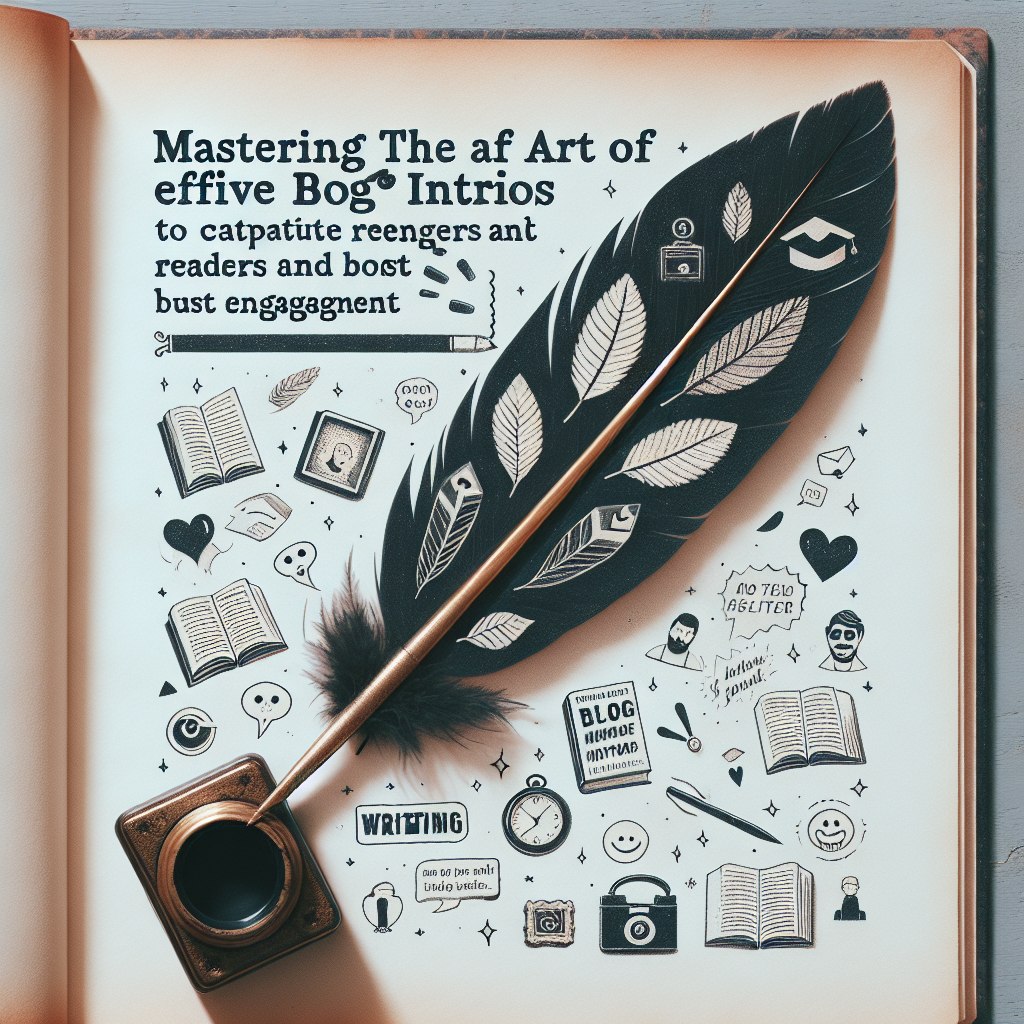Mastering the Art of Writing Effective Blog Intros to Captivate Readers and Boost Engagement
In my experience with writing effective blog intros, I’ve learned that the first few sentences truly set the tone for the entire article. When I started focusing on mastering this skill, I noticed a significant increase in reader engagement and time spent on my posts. I want to share what I’ve learned about writing effective blog intros because I believe they are the gateway to captivating your audience from the very first line.
From what I’ve researched and practiced, writing effective blog intros is both an art and a science. It’s about sparking curiosity, establishing relevance, and providing a compelling reason for readers to continue. I’ve found that understanding the core principles of crafting powerful introductions can dramatically improve your blog’s performance. So, if you’re looking to boost your engagement, I recommend paying close attention to how you begin your posts.
Understanding the Importance of Writing Effective Blog Intros
In my journey as a blogger, I’ve discovered that writing effective blog intros is crucial because it directly influences whether someone decides to keep reading. I’ve seen countless articles with great content buried under weak introductions. When I first started paying attention to my blog intros, I noticed a clear difference—more clicks, longer reads, and increased shares. I believe that mastering writing effective blog intros can transform your entire content strategy.
Why First Impressions Matter
From my experience, the first few sentences are your chance to make a memorable impression. I recommend thinking of your intro as a handshake—firm, confident, and inviting. When I focus on making my first lines compelling, I see a noticeable uptick in reader retention. I’ve learned that writing effective blog intros isn’t just about being catchy; it’s about setting expectations and promising value.
The Impact on SEO and Engagement
I’ve found that well-crafted intros also help with SEO because they include relevant keywords naturally. When I incorporate terms like writing effective blog intros thoughtfully, I improve my chances of ranking higher in search results. Plus, engaging intros encourage readers to stay longer, decreasing bounce rates and increasing the likelihood of shares. I believe that focusing on writing effective blog intros is a win-win for both SEO and audience engagement.
Key Elements of Writing Effective Blog Intros
In my experience with writing effective blog intros, there are several essential components I always aim to include. These elements help me craft introductions that hook readers immediately and motivate them to continue reading. I want to share what I’ve found works best when focusing on these key ingredients.
Starting with a Hook
I’ve discovered that starting with a hook—such as a provocative question, a surprising fact, or a bold statement—can instantly grab attention. When I include a strong hook in my writing effective blog intros, readers are more likely to stay engaged from the outset. I recommend experimenting with different types of hooks to see what resonates with your audience.
Clearly Stating the Value
From my research and practice, clearly conveying the value of your content is vital. I always aim to tell my readers what they will learn or gain by reading further. When I do this effectively, I notice that engagement rates increase because my audience understands the benefit right away. I believe that writing effective blog intros is all about promise and delivery—give them a reason to stay.
Keeping It Concise and Focused
I’ve learned that long-winded intros can lose readers before they even start. I recommend keeping your writing effective blog intros concise—ideally under 100 words. When I trim unnecessary details and focus on a clear, engaging opening, I see higher reader retention and better SEO performance. Less is often more when it comes to introductions.
Practical Tips for Crafting Engaging Blog Intros
Over time, I’ve developed several practical tips to help with writing effective blog intros. These strategies have made a noticeable difference in my writing process and results. I want to share some of these tips so you can start improving your introductions today.
Use Personal Stories or Anecdotes
I’ve found that personal stories immediately create a connection with readers. When I incorporate a brief anecdote into my writing effective blog intros, it humanizes my content and makes it relatable. This approach often results in increased engagement because people love stories they can connect with.
Ask a Thought-Provoking Question
From my experience, asking a question encourages curiosity. I recommend starting your writing effective blog intros with a question that your audience cares about. It’s a simple yet powerful way to draw readers in and make them want to find out the answer.
Use Strong, Actionable Language
I’ve learned that using active language in your intro energizes your writing. Words like “discover,” “uncover,” or “learn” motivate readers to continue. When I craft my writing effective blog intros with a sense of action, I notice higher click-through rates and more engaged readers.
Common Mistakes to Avoid in Writing Effective Blog Intros
In my experience, avoiding certain pitfalls can significantly enhance your writing effective blog intros. Over the years, I’ve identified some common mistakes that tend to weaken introductions and lower engagement. I want to share these so you can sidestep them and craft more compelling openings.
Being Vague or Boring
I’ve seen many bloggers start with generic statements that don’t spark interest. I recommend being specific and lively. When I focus on clarity and excitement in my writing effective blog intros, I immediately attract the right audience.
Overloading with Keywords
From my research, keyword stuffing can harm readability and SEO. I’ve learned that natural inclusion of keywords like writing effective blog intros is key. I recommend integrating keywords seamlessly so they support your message without overwhelming your audience.
Skipping the Hook
I used to jump straight into facts or explanations, but I found that missing a hook lessens interest. I suggest starting with a compelling element—question, fact, or story—to immediately engage your readers.
Tools and Resources to Improve Your Writing Effective Blog Intros
Throughout my journey of perfecting writing effective blog intros, I’ve relied on various tools and resources. These have helped me refine my skills and generate ideas quickly. I want to share some of my favorites that I believe can assist you as well.
Headline Analyzers and Generators
I recommend using tools like CoSchedule Headline Analyzer to craft compelling hooks. These tools help evaluate the strength of your opening lines and suggest improvements. I’ve found that better headlines and intros lead to higher engagement in writing effective blog intros.
Content Planning Templates
Organizing your ideas before writing is crucial. I use templates to outline my writing effective blog intros and main points. This structure ensures my introductions stay focused and impactful.
Educational Courses and Blog Writing Guides
I recommend exploring online courses on platforms like Udemy or Coursera that focus on copywriting and blogging. These resources provide in-depth techniques for writing effective blog intros and creating engaging content.
References and Resources
Throughout my research on writing effective blog intros, I’ve found these resources incredibly valuable. I recommend checking them out for additional insights:
Authoritative Sources on writing effective blog intros
-
How to Write Blog Introductions That Hook Readers
HubSpot.comThis resource offers practical tips for crafting compelling blog introductions that captivate your audience from the first sentence.
-
Effective Blog Intros: How to Hook Readers Easily
Moz.comMoz discusses SEO strategies intertwined with engaging writing techniques, emphasizing the importance of writing effective blog intros.
-
Copyblogger: Mastering Blog Intros
Copyblogger.comA comprehensive guide to crafting effective blog intros that convert readers into loyal followers.
-
Neil Patel: Writing Headlines and Intros That Work
NeilPatel.comNeil shares insights on creating headlines and introductions that boost click-through rates and reader interest.
-
Content Marketing Institute: Effective Blog Intros
ContentMarketingInstitute.comThis article explores strategies for engaging introductions that increase content readability and sharing.
-
Copyhackers: Expert Tips on Writing Effective Blog Intros
Copyhackers.comPractical advice from industry leaders on how to craft intros that resonate and convert.
-
ProfWeb: Tips for Effective Blog Writing
ProfWeb.caAcademic and professional insights into writing engaging blog content, including introductions.
Frequently Asked Questions
What are the key elements of writing effective blog intros?
In my experience, the key elements include a compelling hook, a clear statement of value, and concise language. Incorporating these elements in your writing effective blog intros helps capture attention and set expectations for the rest of your content.
How can I make my blog intros more engaging?
I recommend starting with a strong hook, such as a question or an interesting fact, and keeping your intro concise. From my experience, personal stories or bold statements also help draw readers in. Focusing on the audience’s needs and desires makes your writing effective blog intros more compelling.
What mistakes should I avoid in writing effective blog intros?
Based on my observations, common mistakes include being vague, overloading with keywords, and skipping the hook. I suggest being specific, natural with SEO, and starting with an engaging element to improve your writing effective blog intros.
Are there tools that can help improve my blog intros?
Absolutely! I’ve used headline analyzers, content planning templates, and online courses to refine my writing effective blog intros. These tools provide valuable feedback and structure, making your introductions more engaging and effective.
How important are keywords in writing effective blog intros?
In my experience, keywords are important but should be incorporated naturally. Overstuffing can harm readability and SEO. I recommend focusing on a smooth integration that supports your message, helping your writing effective blog intros rank well without sacrificing quality.
Conclusion
In conclusion, my research on writing effective blog intros has shown that the first impression is everything. Crafting engaging, value-driven introductions sets the stage for higher engagement and better SEO. I hope this guide helps you understand the key elements and practical strategies to improve your blog’s opening lines. Remember, mastering writing effective blog intros is an ongoing process, but with practice, you’ll see your readership grow and your content resonate more powerfully.
Find out more information about “writing effective blog intros”
Search for more resources and information:









